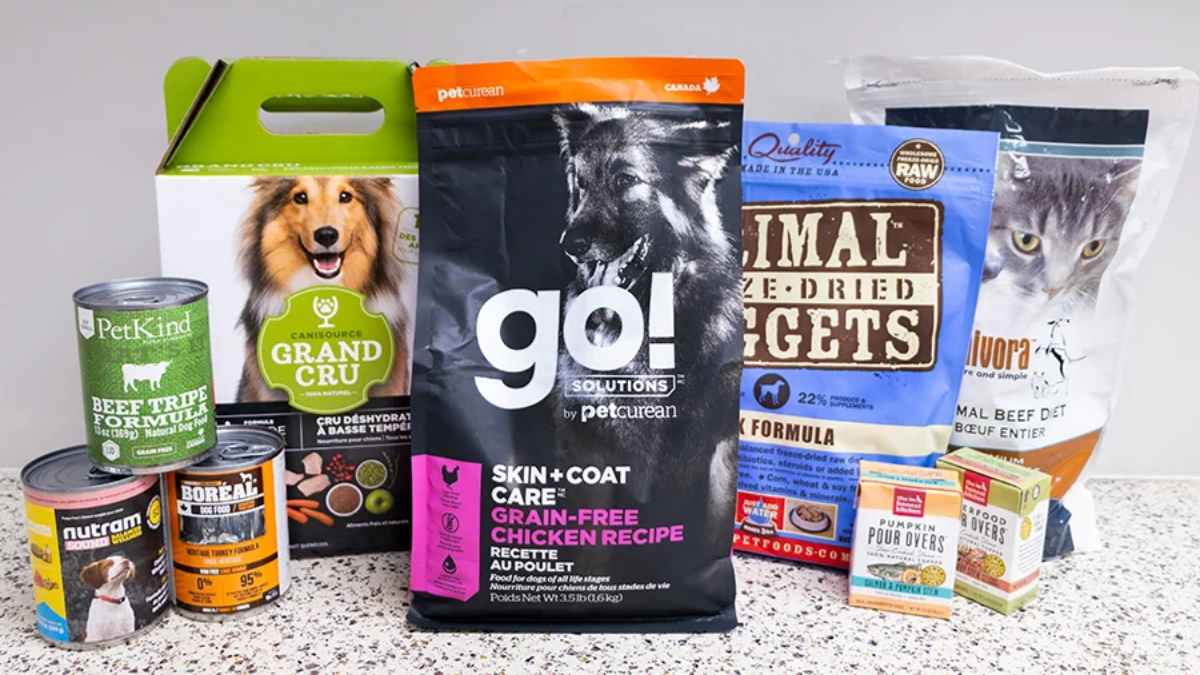Choosing the right type of dog food for your furry friend is essential for their overall health and well-being. With so many different types of dog food available, it can be challenging to know which one is best for your pet. In this blog post, we will discuss the advantages and disadvantages of different types of dog food, including kibble, wet food, semi-moist food, freeze-dried/dehydrated food, and raw food. We’ll also highlight some of the best healthy dog food ingredients to look for when choosing dog food.
Contents
Kibble
Kibble is the most common type of dog food and is made by cooking ingredients and then extruding them into pellets. While kibble is convenient and easy to store, it may contain artificial preservatives and fillers, making it less nutritious than other types of dog food. Additionally, the lower moisture content of kibble can lead to dehydration in some dogs.
Advantages:
- Convenience: easy to store and transport.
- Affordability: generally less expensive than other types of dog food.
- Long shelf life: kibble can last for several months without spoiling.
Disadvantages:
- Lower moisture content: may cause dehydration in some dogs.
- May contain artificial preservatives and fillers.
- Less palatable: some dogs may find kibble less appealing than other types of dog food.
Wet Food
Wet dog food is made by combining ingredients and then cooking them in water. The result is a moist, flavorful dog food that is high in nutrients. Wet dog food is ideal for dogs who have dental issues or need extra hydration.
Advantages:
- Higher moisture content: helps to keep dogs hydrated.
- More palatable: many dogs prefer the taste and texture of wet food.
- Can be beneficial for dogs with dental issues.
Disadvantages:
- Less convenient to store and transport than kibble.
- May be more expensive than kibble.
- Shorter shelf life: wet food typically needs to be refrigerated and consumed within a few days.
Semi-Moist Food
Semi-moist dog food is a type of dog food that is somewhere between kibble and wet food. It is made by cooking ingredients and then adding moisture to create a soft, chewy texture. Semi-moist dog food is convenient and easy to serve, but it may contain higher levels of sugar and salt than other types of dog food.
Advantages:
- Convenient: easy to serve and store.
- More palatable than kibble.
- Longer shelf life than wet food.
Disadvantages:
- May contain artificial ingredients and preservatives.
- Higher in sugar and salt than other types of dog food.
- May be more expensive than kibble.
Freeze-Dried/Dehydrated Food
Freeze-dried and dehydrated dog food are types of dog food that are made by removing the moisture from the ingredients. This process helps to preserve the nutrients in the food and makes it convenient to store and transport.
Advantages:
- High in nutrients: the freeze-drying/dehydration process helps to preserve the nutrients in the food.
- Convenient: easy to store and transport.
- Longer shelf life than wet food.
Disadvantages:
- May be more expensive than other types of dog food.
- Requires rehydration before serving.
- May be less palatable than wet food.
Raw Food
Raw dog food is made from raw meat, bones, and organs, and is similar to the diet of a wild dog. While raw dog food is high in nutrients and may promote healthy digestion, it requires special storage and handling and may pose health risks to both dogs and humans.
Advantages:
- High in nutrients: raw dog food is unprocessed and high in nutrients.
- May promote healthy digestion.
Disadvantages:
- More expensive than other types of dog food.
- Requires special storage and handling to prevent contamination.
- Potential health risks to both dogs and humans include bacterial infections and nutritional imbalances.
Healthy Dog Food Ingredients
When choosing dog food, it’s important to look for healthy ingredients that provide balanced nutrition. Here are several high-quality proteins that are often used in dog food:
- Chicken: is a great source of protein and is commonly found in many dog food brands. It is easily digestible and contains essential amino acids that help maintain your dog’s muscle mass.
- Beef: nutrient-rich protein source that contains essential vitamins and minerals. It is often found in high-quality dog food and can help your dog maintain healthy muscles and bones.
- Fish: Such as salmon and trout, are high in omega-3 fatty acids, which can help support healthy skin and coat in dogs. Fish is also a great source of protein and is easily digestible for dogs with sensitive stomachs.
- Lamb: Often used in dog food for its high-quality amino acids. It can help support your dog’s overall health and well-being.
- Duck: Duck is a high-quality protein source that is rich in nutrients and can help support your dog’s muscle development. It is also a good option for dogs with food sensitivities.
Overall, it’s important to choose a high-quality protein source for your dog’s food to ensure they receive the essential nutrients they need for optimal health.
Choosing the right type of dog food is essential for your pet’s overall health and well-being. While kibble is convenient and easy to store, other types of dog food like wet food, semi-moist food, freeze-dried/dehydrated food, and raw food may offer additional benefits. When choosing dog food, it’s also important to look for healthy ingredients that provide balanced nutrition. By considering your dog’s unique needs and preferences, you can select the best dog food to support their health and happiness.

